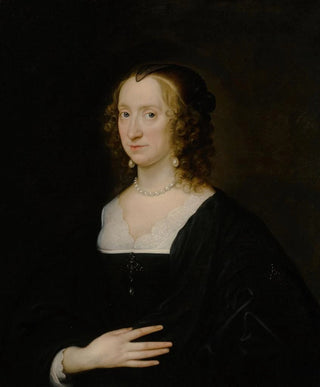Art print | Portrait of an Elegant Woman - School of Antoine van Dyck


View from behind

Frame (optional)
Portrait of an Elegant Woman - School of Antoine van Dyck – Captivating Introduction
The "Portrait of an Elegant Woman" from the School of Antoine van Dyck is a masterpiece that transcends time, capturing the very essence of beauty and sophistication of the 17th century. This painting, imbued with delicacy and refinement, evokes a courtly atmosphere where elegance and savoir-vivre are paramount. The depiction of a woman whose gaze appears both mysterious and engaging invites the viewer to delve into a universe where every detail matters. Light subtly caresses the features of her face, highlighting the finesse of her traits and the richness of her attire. This work is much more than a simple portrait; it is a window into a bygone era, a testament to an art that masterfully combines realism and idealization.
Style and uniqueness of the work
The style of this art print stands out for its realistic approach, typical of Baroque art, while maintaining an almost idealized dimension. The color palette, rich and nuanced, plays a crucial role in the composition. Warm and golden tones evoke natural light, while delicate shadows add depth and dimension to the figure. This play of light and shadow, dear to van Dyck, gives the woman an almost lifelike presence, as if she were about to come to life. The details of her clothing, carefully rendered, testify to exceptional craftsmanship. Every fold, every embroidery is an element that highlights the haute couture of the period, reflecting the social status of the depicted figure. In sum, this portrait is a celebration of feminine beauty, an ode to timeless elegance.
The artist and his influence
Antoine van Dyck, a pupil of Rubens, is one of the undisputed masters of portraiture in the 17th century. His ability to capture not only the physical appearance but also the personality of his subjects has left a mark on art history. Van Dyck skillfully blended Flemish influence with a more Italian style, creating portraits of great expressiveness. His impact on European art is undeniable, inspiring many artists across the

Matte finish

View from behind

Frame (optional)
Portrait of an Elegant Woman - School of Antoine van Dyck – Captivating Introduction
The "Portrait of an Elegant Woman" from the School of Antoine van Dyck is a masterpiece that transcends time, capturing the very essence of beauty and sophistication of the 17th century. This painting, imbued with delicacy and refinement, evokes a courtly atmosphere where elegance and savoir-vivre are paramount. The depiction of a woman whose gaze appears both mysterious and engaging invites the viewer to delve into a universe where every detail matters. Light subtly caresses the features of her face, highlighting the finesse of her traits and the richness of her attire. This work is much more than a simple portrait; it is a window into a bygone era, a testament to an art that masterfully combines realism and idealization.
Style and uniqueness of the work
The style of this art print stands out for its realistic approach, typical of Baroque art, while maintaining an almost idealized dimension. The color palette, rich and nuanced, plays a crucial role in the composition. Warm and golden tones evoke natural light, while delicate shadows add depth and dimension to the figure. This play of light and shadow, dear to van Dyck, gives the woman an almost lifelike presence, as if she were about to come to life. The details of her clothing, carefully rendered, testify to exceptional craftsmanship. Every fold, every embroidery is an element that highlights the haute couture of the period, reflecting the social status of the depicted figure. In sum, this portrait is a celebration of feminine beauty, an ode to timeless elegance.
The artist and his influence
Antoine van Dyck, a pupil of Rubens, is one of the undisputed masters of portraiture in the 17th century. His ability to capture not only the physical appearance but also the personality of his subjects has left a mark on art history. Van Dyck skillfully blended Flemish influence with a more Italian style, creating portraits of great expressiveness. His impact on European art is undeniable, inspiring many artists across the






